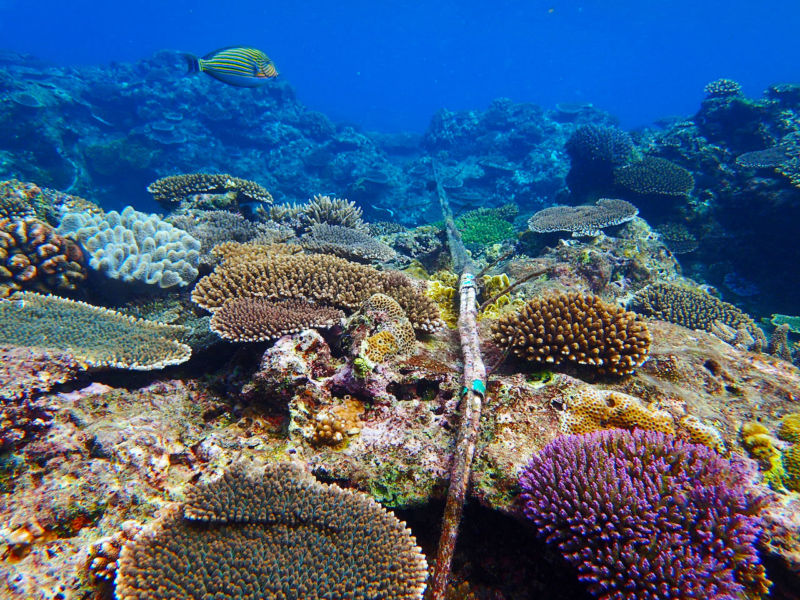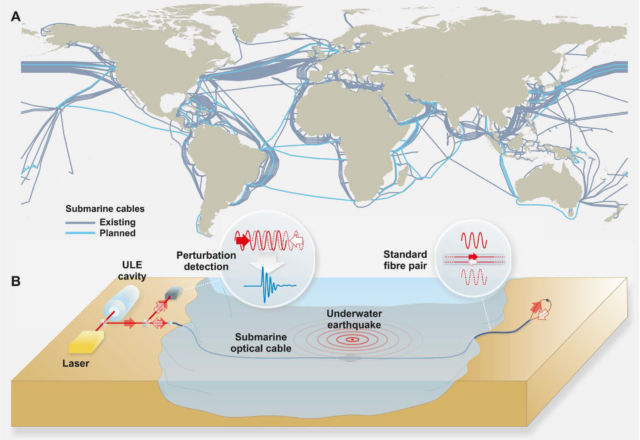A DEAL AT TWICE THE PRICE —
Seafloor fiber optic cables can work like seismometers
Anything that shakes the cable can be detected with the right setup.

Enlarge / "Did you feel that?"
There are enough seismometers around these days to detect and locate nearly all earthquakes on land, except the most minuscule ones. The seafloor is another story. It’s expensive and difficult to maintain seismometers at the bottom of the ocean, so our coverage is pretty sparse. Earthquakes smaller than a magnitude four won’t register in many places—and “many places” in the ocean means a large portion of the planet.
A group of researchers led by Giuseppe Marra of the UK’s National Physical Laboratory accidentally stumbled on an inexpensive way to fill in many of the gaps. They were working on advanced fiber optic links capable of connecting things like next-gen atomic clocks around Europe. At this level of sensitivity, any vibrations near the cable introduce noise in the signal, which is generally a nuisance to be overcome.
But while running an experiment on a UK cable in August 2016, they realized the noise in the line was coming from a magnitude 6.0 earthquake in Italy. As the seismic waves pass through the fiber, the resulting distortion slightly delays the signal, causing a measurable shift in the peaks and troughs of the oscillating light wave.
Just like a seismometer, the faster moving primary seismic wave is seen first, with the slower secondary wave right behind it. The length of the time gap between the two indicates how far away the earthquake occurred. Because the signal was sent down one fiber and returned on another, the timing of the noise on the “coming” and “going” fibers showing up at the detector allows you to calculate which point along the fiber first felt the seismic waves.
In order to triangulate the location of an earthquake’s epicenter, you need (surprise!) three seismometers. But because you can calculate that point of first contact along a lengthy cable, you actually only need two cables to map an epicenter.
As they investigated the idea of using fiber optical cables as earthquake sensors, they detected other earthquakes using other cable links in the UK and Italy. The best result, they found, was on a seafloor cable linking Malta and Sicily—it’s quieter down there in the ocean, with fewer sources of vibrational noise.
And that led to the researchers’ big idea: what if the network of telecommunication cables crisscrossing the oceans could serve double duty as seismometers? That could greatly expand our knowledge of seismic activity on the remote seafloor.

Enlarge / Here's the network of seafloor cables that could be used to detect earthquakes.
The technique relies on a device that maintains a perfectly stable frequency of laser oscillations so that any changes to the signal are obvious. That means you can’t use the data being transmitted on these cables as your earthquake-monitoring signal.
Fortunately, very little of a cable’s capacity would have to be commandeered in service of seismology. Each cable carries data on many channels split across different wavelengths of light and multiple pairs of fibers in the bundle. Only one channel would need to be repurposed, with a stabilized signal generator and a detector on each end.
The researchers point out that such a network could possibly be used for other purposes, too, like studying noise pollution in the ocean or even tracking marine mammals as they migrate. Even if cables don’t work quite as well, this would certainly be cheaper than building out global networks of seismometers and microphones—anything that saves you a few hundred trips to the bottom of the ocean is probably worth it.
No comments:
Post a Comment